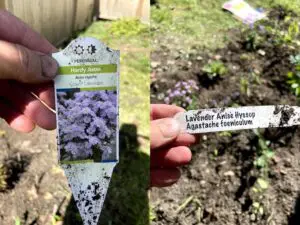I bought many plants before I understood the value of reading the labels and could decipher them. Now that garden centers are stocked for spring and plant sales are underway, it’s a good time for a refresher.
A plant tag may contain no more than its Latin name (an international standard) and its common name, usually regional and one of many. That’s fine if you know the plant’s needs and habits. Otherwise, be wary of bringing it home. If there is only a common name listed, I wouldn’t buy it without checking a botanical key.
I’ve found that the smaller the nursery, the less likely it will have helpful tags. That’s because larger retailers source plants from industry growers such as American Beauties Native Plants, Proven Winners and American Meadows, which attach tags standardized across species with details about water needs, growing zones, sun requirements and height and width, as well as a description of blooms and other features.

The labels on native plants might include information about their ecological value or if they are good hosts for bugs, butterflies or caterpillars. Because these are selling points for gardeners who want to create habitats, I’m seeing these details included more frequently. It’s a feel-good moment to take home a plant that is beautiful and useful.
While researching this column, I came across a native grass, pink muhly, on the website of a box store and noted that the customer reviews were all negative — everyone complained about its slow growth. This reinforces the value of purchasing plants from a store where a knowledgeable staff person can help you. Pink muhly grass (Muhlenbergia capillaris) is a warm-season grass that doesn’t reach its full height until later in the summer and looks lovely through the fall and winter. Cool-season grasses will come up early and reach maturity in late spring or early summer. Expectations matter a lot when pursuing satisfied customers.
In 2015, the state Department of Environmental Conservation prohibited commercial sales of certain invasive species and required that labels be attached to six species that read: “Invasive Species — Harmful to the Environment.” These include Norway maple, burning bush and Chinese silver grass. All of these spread prolifically. Although I don’t have burning bush, my neighbors do and I am constantly pulling seedlings. Beware of inviting plants that come with warning labels into your yard.
Last summer a bill was introduced in Congress that would address the use of pesticides on pollinator plants. Supported by the Xerces Society and other environmental organizations, it would create a USDA certification for pollinator-safe plants. If adopted, growers could satisfy requirements that their native plants are produced using organic methods that protect the health of butterflies and other pollinating insects.
Studies have shown that milkweed, a host plant for the endangered monarch, is often treated with pesticides that kill monarch caterpillars that feed on it. A well-meaning gardener trying to create a habitat for monarchs might inadvertently poison the species. The bill has not progressed, but the effort is worthwhile.
Plant sales
Stonecrop in Philipstown and the Native Plant Center in Valhalla will each host plant sales on April 27. The Philipstown Garden Club, the Master Gardeners in Putnam County and the Verplanck Garden Club in Fishkill are planning sales in May. See The Current’s calendar for details.

